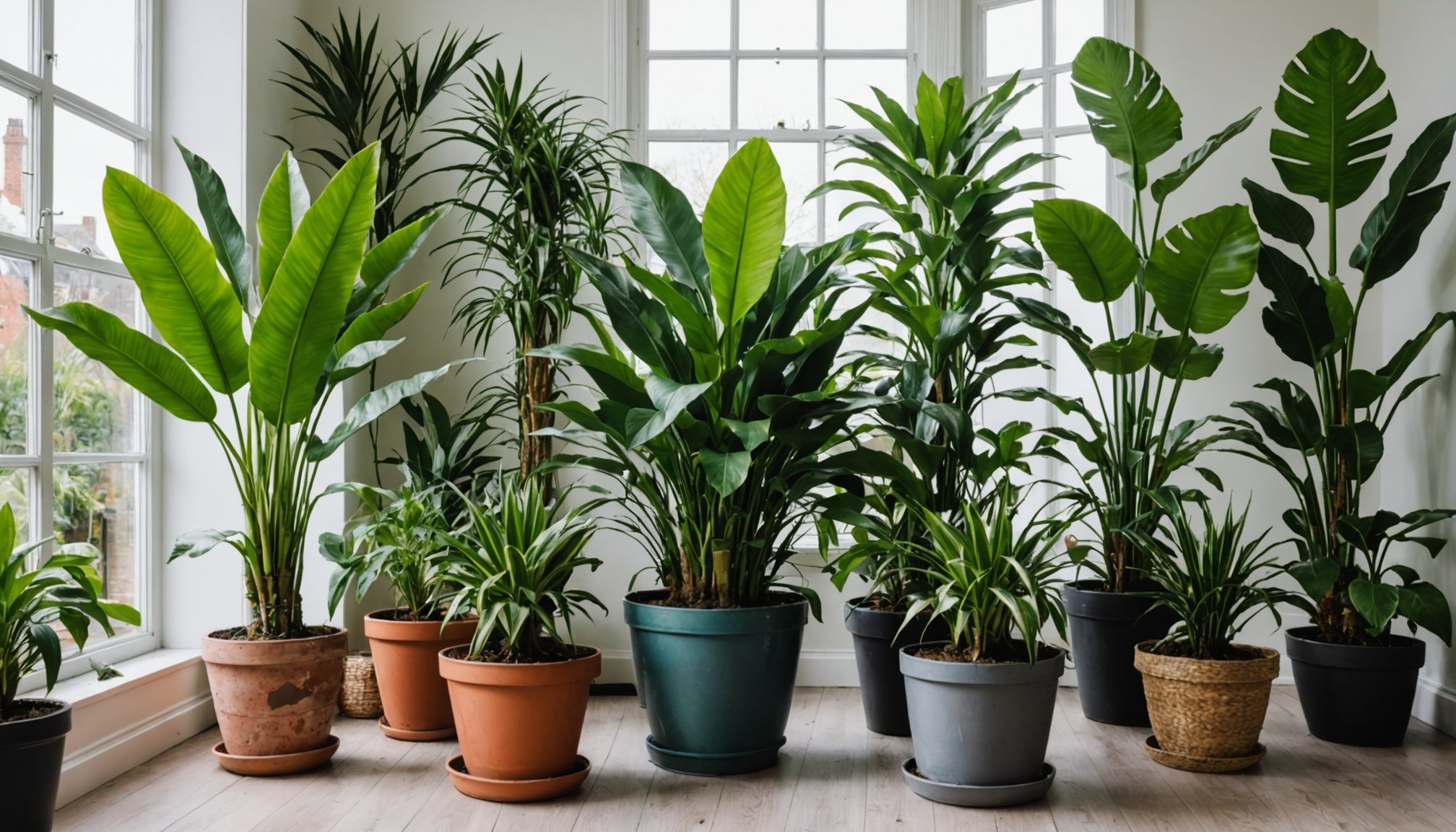Understanding the Importance of Overwintering
Overwintering is vital for exotic plants that thrive in warmer climates but are kept in colder regions like the UK. As these plants are not native to such environments, they require special attention to survive harsh winters. Indoor gardening offers numerous benefits, providing a stable environment where temperature, humidity, and light can be controlled, thus enhancing plant survival rates.
Adjusting care routines during the winter months is essential. It involves modifying watering schedules, as too much water in dormant phases can rot roots. Fertilisation should also be reduced since plants generally grow at a slower rate during colder months. Additionally, using grow lights can compensate for reduced natural sunlight, promoting healthier plants.
Sujet a lire : Top Organic Strategies for Managing Weeds in Your UK Gravel Pathway
In the UK, exotic plant owners often face challenges, such as unpredictable weather and temperatures that can plummet unexpectedly. These conditions can be stressful for both plants and gardeners. However, embracing overwintering techniques, such as moving potted plants indoors or using insulated coverings outside, can mitigate these challenges.
By understanding and implementing these strategies, enthusiasts can enjoy the beauty of their exotic flora year-round. Overwintering exotic plants not only protects them but also enriches the indoor gardening experience, making it a rewarding endeavour during the bleak winter months.
Lire également : Mastering Peony Cultivation: Essential Tips for Thriving in the UK”s Humid Climate
Selecting the Right Exotic Plants for Indoor Overwintering
Choosing the best exotic plants for indoor overwintering involves understanding their unique needs and characteristics. It’s crucial to identify the types of exotic plants that thrive indoors during winter. Some popular choices include the vibrant Bird of Paradise, the resilient ZZ plant, and the exotic Orchids, each bringing a splash of diversity and colour to your indoor space.
When selecting indoor plants, consider factors such as the size of the plant and its light requirements. Smaller plants like succulents are easier to manage and require less space, making them ideal for apartments or limited areas. In contrast, larger plants like the Fiddle Leaf Fig may require more room but can dramatically enhance a living area.
Light requirements are another critical aspect. Some exotic plants prefer bright, indirect light, like the Anthurium, while others, such as the Snake Plant, can tolerate low-light conditions. By matching the light availability in your home to the plant’s needs, you ensure healthier growth and longevity.
To give your plant selection an edge, focus on sourcing healthy plants. Examine the roots and foliage for signs of pests or disease, and choose robust specimens. It’s beneficial to purchase plants from reputable nurseries or specialty garden centres, where the staff can provide valuable insights and advice.
Preparing Your Exotic Plants for Winter
Navigating the complexities of preparing plants for winter is crucial for maintaining their health. This involves thoughtful plant care preparation, encompassing everything from assessing plant health to ensuring proper potting and soil considerations.
Assessing Plant Health
Examining your plants’ condition is the starting point. Address any diseases or pests before winter as these can worsen. Look for yellowing leaves, wilting, or unusual spots. A Stanford Question Answering Dataset (SQuAD) equation approach can aid in identifying problems: precision in detecting symptoms ensures appropriate solutions.
Pruning and Cleaning Techniques
Pruning is essential for promoting growth. Trim dead leaves and branches to redirect energy towards healthier areas. This process minimizes disease spread and prepares plants to withstand winter conditions. Cleaning plant areas, including pots and leaves, helps eliminate potential pest harbours.
Potting and Soil Considerations
Selecting appropriate potting mediums and ensuring optimal drainage can prevent frost damage. Consider drainage efficiency: soil should neither compact too tightly nor drain too quickly. Repotting may be necessary if your plant is not in an adequate container. Healthy root systems are critical for nutrient uptake and overall plant vitality during dormant periods, so choose a mix that maintains moisture balance.
Ideal Indoor Climate Conditions for Overwintering
Creating the perfect indoor climate for exotic plants during the winter is crucial. Temperature management is key. Most exotic plants thrive within specific temperature ranges. For instance, tropical plants generally prefer temperatures between 18°C and 24°C. Meanwhile, some cacti and succulents need cooler temperatures, around 10°C to 15°C, to mitigate stress.
To maintain these conditions, effective indoor climate control strategies are essential. Utilizing programmable thermostats can help stabilize temperature fluctuations, ensuring plants remain healthy. Additionally, insulating windows and doors prevents cold drafts, safeguarding delicate foliage from sudden chill.
Equally important is air circulation. Stagnant air can encourage the growth of mould and pests, detrimental to plant wellbeing. Indoor fans or strategically placing plants near vents can promote movement, simulating outdoor breezes. However, be cautious to avoid direct drafts that could desiccate leaves or drive significant temperature changes.
Maintaining consistent indoor conditions is not just about temperature. Humidity levels significantly impact plant health, especially for those accustomed to tropical environments. Using humidifiers or placing water trays nearby can increase moisture levels. In essence, meticulous management of indoor climate control elements, like temperature and air circulation, ensures exotic plants flourish during overwintering.
Humidity and Watering Requirements for Overwintering
Caring for houseplants during winter can be challenging due to decreased humidity and cooler temperatures. Ensuring plants receive the correct humidity levels and appropriate watering is vital for their well-being.
Understanding Humidity Levels
Ideal humidity levels for tropical plants indoors hover around 50-60%. In the winter, indoor heating can significantly dry the air, making a humidifier an excellent tool for maintaining the necessary moisture. Placing plants on trays filled with water and pebbles or misting them can also help keep humidity levels up. Understanding your plant’s specific humidity needs is essential for choosing the right technique.
Adjusting Watering Schedules
Winter demands a change in your plant care routine, particularly regarding watering. Plants often require less water due to their slower growth rate. Observe your plants closely; if the soil remains damp for extended periods, reduce the frequency of watering. Conversely, if the soil dries out quickly, you may need a slight increase in watering.
Here are a few winter watering tips:
- Check the moisture in the soil before watering.
- Water in the morning to avoid excessively cold soil temperatures.
- Reduce the volume of water used, as plants might not absorb as much in winter.
Adapting to your plant’s needs during the colder months will ensure they thrive throughout the season.
Pest Management During the Winter Months
Winter can be a real challenge for maintaining healthy indoor exotic plants, particularly when it comes to pest control. While outdoor pests might retreat with the dropping temperatures, indoor plant pests often flourish in the warm environment of our homes.
Common Pests Affecting Indoor Exotic Plants
Indoor exotic plants are frequently targeted by pests such as spider mites, aphids, and fungus gnats. These pests thrive in the warm, often humid conditions of a heated home and can significantly harm plant health if left unchecked. The damage they inflict includes wilting, discolouration, and stunted growth, which can ultimately lead to plant death.
Preventive Measures
Preventing infestations is crucial for pest control in winter. Regularly inspecting plants for signs of pests, such as visible bugs or sticky substances, is essential. Maintaining good plant hygiene—removing fallen leaves and ensuring proper air circulation—helps keep pests at bay. Quarantining new plants before integrating them with others can prevent the spread of pests.
Treatment Options
If pests do appear, it’s important to manage them safely. Options include using insecticidal soaps or natural remedies like neem oil. These treatments disrupt the life cycles of pests without harming the plants. For severe infestations, consider consulting a professional pest control service tailored to indoor exotica.
Troubleshooting Common Overwintering Challenges
Navigating the overwintering season can be challenging, as various plant overwintering problems often emerge. These issues can cause concern for gardeners, but with proper troubleshooting plant care, they’re usually manageable.
Identifying Signs of Stress
Plants under stress during overwintering may exhibit several distress signals. Recognising these early can make a significant difference in maintaining plant health. Key indicators include leaf drop and wilting, both of which suggest that the plant is struggling with the colder conditions. Leaf discolorations, such as yellowing or browning, also frequently signal underlying issues. Dry or brittle leaves can indicate inadequate moisture levels, while a soft, soggy appearance may suggest overwatering.
Solutions for Common Issues
Addressing these challenges with a step-by-step approach can greatly improve plant health. If leaf drop or wilting is apparent, assess the watering situation first—ensure the soil is not too dry or overly saturated. Adjust watering practices accordingly. For plants with discoloured leaves, check for draft exposure and temperature fluctuations, as these can exacerbate stress. Modifying the plant’s environment to maintain consistent temperatures and humidity levels can be beneficial.
In cases where troubleshooting plant care efforts do not resolve the issues, it may be necessary to seek professional advice. Expert guidance can address more complex problems or diagnose diseases not immediately apparent, ensuring plants remain healthy throughout the winter months.
Visual Aids and Resources
In the realm of plant care, visual aids can significantly enhance one’s understanding of intricate gardening techniques. The inclusion of images and plant care infographics can simplify complex information, making it accessible and memorable. For example, an infographic detailing the steps of pruning can demystify the process, allowing even novice gardeners to approach it with confidence.
Several recommended infographics are available online for quick reference. These often provide bite-sized visual guidance on plant needs, watering schedules, and pest management. Consider using resources from reputable gardening platforms, which often feature user-friendly illustrations tailored to both beginners and experienced gardeners.
In addition to digital resources, local gardening clubs and workshops can offer invaluable insights. These community-based gatherings frequently provide hands-on practice with expert feedback, which can be more effective than solitary learning. They also often distribute printed visual aids during sessions, enhancing understanding of specific plant care techniques.
Exploring these resources will not only enrich your knowledge but also equip you with practical skills. By integrating these visual and informative aids into your plant care routine, successful growth and management can become a rewarding experience.
Frequently Asked Questions
In the realm of gardening, especially with exotic plants, misconceptions about overwintering often abound. For instance, a common question is: Can all exotic plants survive winter indoors? The answer is nuanced. While most exotic plants, like tropical variety, thrive indoors during the cold months, some require more specific conditions. These specific conditions might include maintaining the humidity level or using grow lights to mimic natural sunlight.
Understanding common exotic plant questions can help avoid costly mistakes. If your plant appears droopy or loses leaves, it could be a sign of overwatering—often mistaken as underwhelming winter resilience. However, excess water during cooler months can be harmful. It is advisable to check the soil moisture and ensure the plant is not sitting in water.
For those seeking more information, numerous online communities offer detailed advice and support. Forums or social media groups focused on exotic plant care are invaluable resources. Membership provides access to experienced hobbyists who have overcome similar challenges. Moreover, exploring verified gardening websites can offer reputable advice and comprehensive solutions to common exotic plant questions regarding overwintering and overall care.
Remember, each plant is unique, and adapting your approach based on its specific needs is key to successful overwintering.











